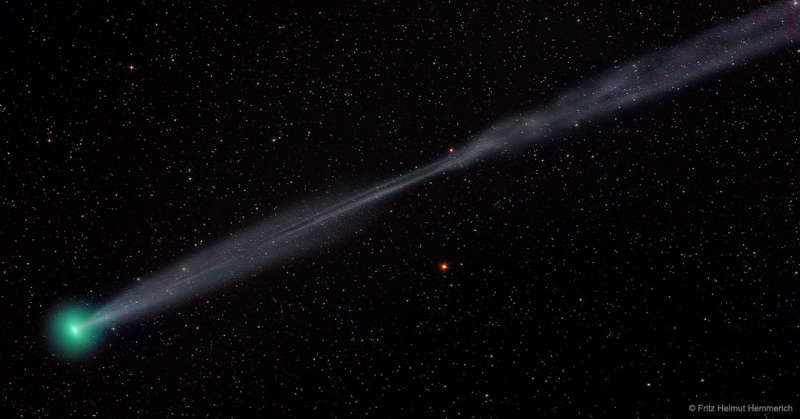
|
Credit & Copyright: Fritz Helmut Hemmerich
Explanation:
What's happened to Comet Lovejoy?
In the
pictured image, a processed
composite,
the comet was captured early this month after brightening unexpectedly and sporting
a long and intricate
ion tail.
Remarkably, the typically complex effect of the
Sun's wind and
magnetic field
here caused the middle of
Comet Lovejoy's
ion tail to resemble the head of a needle.
Comet C/2017 E4 (Lovejoy) was discovered only last month
by
noted
comet
discoverer
Terry Lovejoy.
The comet reached
visual magnitude 7
earlier this month, making it a good target for binoculars and long duration
exposure cameras.
What's happened to
Comet Lovejoy (E4)
since this image was taken might be considered even more remarkable --
the comet's nucleus appeared to be
disintegrating
and fading as it neared its closest approach to the
Sun two days ago.
|
January February March April May June July August September October November December |
| ||||||||||||||||||||||||||||||||||||||||||||||||
NASA Web Site Statements, Warnings, and Disclaimers
NASA Official: Jay Norris. Specific rights apply.
A service of: LHEA at NASA / GSFC
& Michigan Tech. U.
Based on Astronomy Picture
Of the Day
Publications with keywords: comet - comet tail
Publications with words: comet - comet tail
See also:
- APOD: 2025 December 1 Á 3I ATLAS: Tails of an Interstellar Comet
- APOD: 2025 November 25 Á Comet Lemmon and the Milky Way
- 3I/ATLAS: A View from Planet Earth
- APOD: 2025 November 17 Á Comet Lemmons Wandering Tail
- APOD: 2025 September 30 Á Comet Lemmon Brightens
- APOD: 2025 September 29 Á Two Camera Comets in One Sky
- APOD: 2025 September 26 Á A SWAN an ATLAS and Mars
